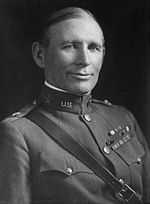Dennis E. Nolan
| Dennis Edward Nolan | |
|---|---|
|
Gen. Dennis E. Nolan | |
| Born |
April 22, 1872 Akron, New York |
| Died |
February 24, 1956 (aged 83) New York City, New York |
| Allegiance |
|
| Service/branch |
|
| Years of service | 1896–1936 |
| Rank |
|
| Commands held |
|
| Battles/wars |
|
| Awards |
|
| Other work | President, U.S. Military Academy Association of Graduates |
Dennis E. Nolan (April 22, 1872 – February 24, 1956) was a career officer with the United States Army through three wars. He distinguished himself by heading the first modern American military combat intelligence function during World War I. Nolan served as the head football coach at the United States Military Academy in 1902, compiling a record of 6–1–1.
Early life, education, football coaching career
Born in Akron, New York, outside of Buffalo, New York, Nolan was the son of an Irish immigrant. He graduated from the United States Military Academy in 1896. In 1902, Nolan coached the Army football team to a record of 6 wins, 1 loss and 1 draw.[1] The New York Times of 1930s noted that many contemporary U. S. Generals (Nolan, Leon Kromer, Malin Craig, Paul Bunker) were connected by past football experience at West Point.[2][3]
Military career
Starting in August 1920, Nolan, then a brigadier general, served for a year as the War Department Chief of Military Intelligence Division.
From 1927 to 1931, Nolan was commander of Fifth Corps Area, headquartered at Fort Hayes at Columbus, Ohio, one of and geographically the largest of nine corps areas established in the continental United States for the administration of the regular army and reserves by the National Defense Act of 1920. As a corps area commander, he oversaw peacetime training for Army Reserves and the National Guard. In time of war, the corps areas would theoretically have ready made corps combat command structures in place to administer regiments of Regular Army, Reserve and National Guard. During the lean post-war and Great Depression years of military spending, he as well other corps commanders were expected to maintain good relations with the public and civilian officials.
Nolan accepted his final posting as commanding general of Second Corps Area, in charge of army units and facilities in New York, New Jersey, Delaware and Puerto Rico on December 1, 1931. On October 1, 1933, U.S. First Army was reestablished, co-located and co-staffed with Second Corps Area at Fort Jay, Governors Island, New York. Nolan became First Army's first peace time commander. Nolan ended his active duty army career upon retirement on April 30, 1936.
Death and honors
Nolan died on February 24, 1956 in New York City and was buried in Arlington National Cemetery. General Nolan is a member of the Military Intelligence Hall of Fame.
Head coaching record
| Year | Team | Overall | Conference | Standing | Bowl/playoffs | ||||
|---|---|---|---|---|---|---|---|---|---|
| Army Cadets (Independent) (1902) | |||||||||
| 1902 | Army | 6–1–1 | |||||||
| Army: | 6–1–1 | ||||||||
| Total: | 6–1–1 | ||||||||
Notes
- ↑ Dennis E. Nolan at the College Football Data Warehouse
- ↑ Many of Army's Football Stars Now Hold High Rank in Service. The New York Times, October 16, 1935.
- ↑ Many West Point Athletes Who Became Generals. The New York Times, August 2, 1931.
References
- Kovach, Karen (1998). The Life and Times of Dennis E. Nolan, 1872-1956: The Army's First G2 (PDF). Fort Belvoir, Virginia: United States Army, History Office, Office of the Chief of Staff, Intelligence and Security Command.
External links
| Military offices | ||
|---|---|---|
| Preceded by Hunter Liggett |
Commanding General of the First United States Army 1 October 1933 to 30 April 1936 |
Succeeded by Fox Conner |
|
